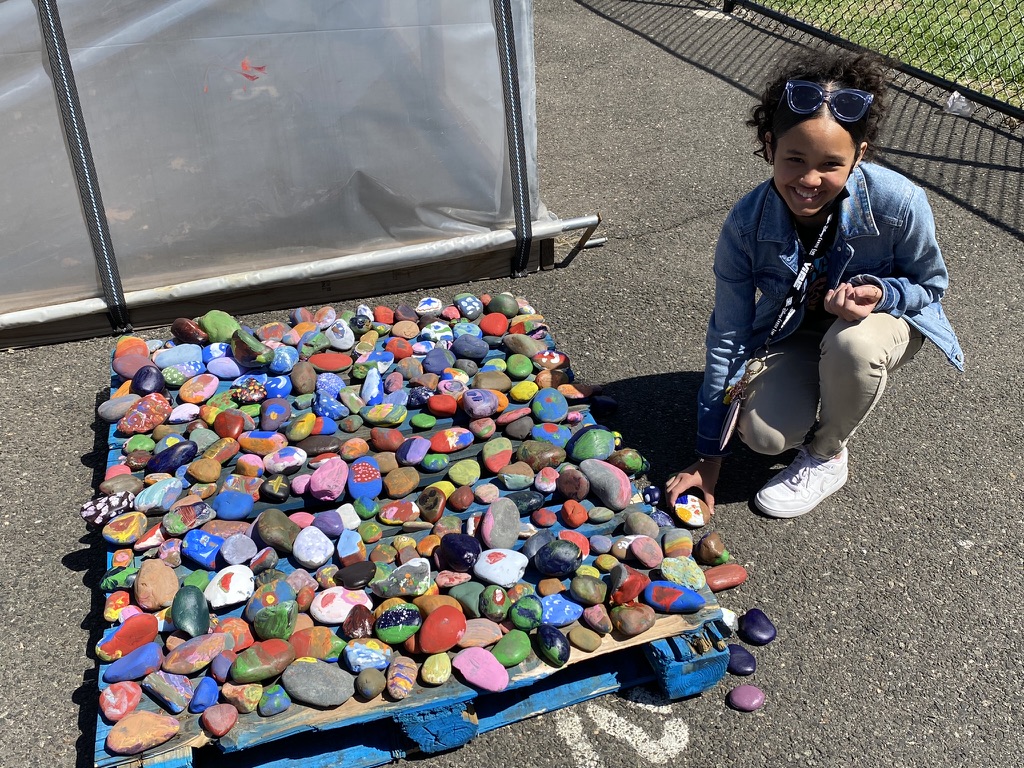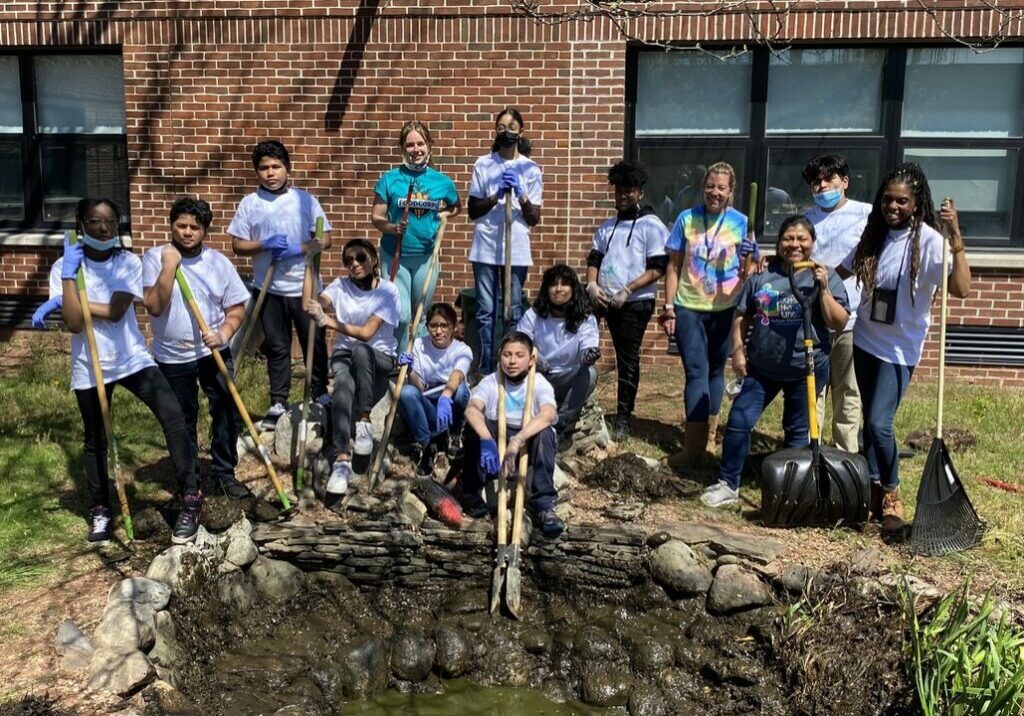NBEA leverages FAST grant for environmental activities
By Angel Boose
Earth Day brings a variety of exciting opportunities to focus on recycling, conserving energy, increasing plant growth, saving water and keeping the environment clean. It also provides an opportunity to get everyone outside for some hands-on learning. The McKinley Community School in New Brunswick did just that, hosting an extraordinary Earth Day Event on April 22. The theme of the event was McKinley Cares: Caring for the Earth, the Community and Ourselves!
Students, families and teachers took part in making the Earth Day Event a huge success. It was sponsored by the New Brunswick Education Association FAST program and organized by Shan Byrd and members of the school’s Environmental Club. Those members included Abby Reed from Elijah’s Promise & Food Corps, educators from the school including Laura Schwahl, Nicole Mudryk, Silvina Rivera-Clifford and Quincey Schenck as well as a host of elementary and middle school students.
FAST is the NJEA Families and Schools Work Together for Children program.
It had been Principal Janene Rodriguez’s dream to get the school’s greenhouse up and running, so she enthusiastically gave Byrd much latitude to lead the Earth Day Event. Rodriguez had the foresight to request that McKinley be themed an environmental school. The Earth Day event was a major step in making the greenhouse a functional learning space.
“This Earth Day event is a demonstration of what restorative justice practices look like in real time,” said Byrd. “It portrays the finer elements of community building: the amplification of the gifts of the collective, and shared leadership among students, staff members and parents.”
Educators, parents and community volunteers lead art and science activities
Volunteers who led activities were asked what they wanted to do to support Earth Day. They organized activities around their hobbies and interests, which were then divided among stations. These included the cleanup of Koi Pond, classes on nutrition, a poetry slam, mural design, greenhouse seeding, rock painting, plant propagation, recycled sculpture presentations, composting, planting wildflower seeds, and an opportunity to get moving with environmental cleanup led by the physical education department. Students from grades K-4 took part in scheduled activities in the morning while students from grades 5-8 engaged in the activities in the afternoon. Grade 4 classes also participated in an Environmental Sustainability workshop presented by Junior Achievement.
This Earth Day Event is a demonstration of what restorative justice practices look like in real time.
Patrick Hall, a contractor, led students, parents, and educators in cleaning the pond. They would ultimately put in fresh water, paint the rocks and make the space more tranquil.
“The difference between a pond and a pool is that a pond has fish,” said Hall. He’s an expert in swimming pools, but was more than happy to lead the community in the pond clean up. Volunteers put on gloves, grabbed rakes, and got to work moving and cleaning debris from the rocks, scrubbing algae away, and removing smelly, muddy water to begin beautifying the space. The students were especially engaged.
Educators and parent volunteers built raised garden beds near the pond. Some were made from a sturdy plastic while other were made with wood purchased by the Environmental Club. Parent Jessica Cabrera was so dedicated to helping with the event that she visited the school during her lunch hour. All volunteers worked vigilantly to provide a space for the students to later plant vegetation of various sorts.

Rock paining was one of many activity stations students enjoyed.
Out by the greenhouse, students participated in various activities. Rich Ciancia labored tirelessly at his station organizing the wildflower plots so that each class had the opportunity to sow seeds. At another station, students selected one of various seeds to plant in a small pot to take home and grow on their own. An additional station allowed students to paint rocks and tiles. Once dry, they would be placed in the school garden to make it a more lively, colorful space.
Teacher Tamara Caruso volunteered to organize a poetry slam, a timely activity because April is National Poetry Month. She taught the students about Langston Hughes and how to recite poetry of their own. She began with an activity where she recited a line and invited students to take turns adding a line to demonstrate the building of a poem.
Students later went up to share poems about the things they love. Some were shy and reserved initially, but teacher Natasha Branscomb volunteered to show the students how it’s done, using her words to recite a poem about teaching. Students grew more confident in their performances. One male student embraced the stage after Branscomb’s demonstration and recited a poem about football using body language to illustrate his words.
Jessica Rodriguez, the school’s art teacher, led students in creating Earth Day murals. Three murals were positioned along different walls in an outdoor area for students to add their creative touch. One mural displayed the ocean, another a tree, and the last was a representation of all things Earth Day. A fourth mural was positioned on the ground. In the same area, students were able to use sidewalk chalk to beautify the ground and to decorate tiles placed on the outside of the school building with images they associated with Earth Day.
Middle school student ambassadors lend a hand
Middle school students from the Environmental Club donned uniform shirts they designed by hand, so everyone knew they were student ambassadors. The shirts were made specifically for Earth Day. After taking a break for lunch, the students traveled in pairs to lower elementary school classrooms to read books. Some of the titles included The Wisdom of Trees: How Trees Work Together to Form a Natural Kingdom by Lita Judge, Bilal Cooks Daal by Aisha Saeed, and Anywhere Farm by Phyllis Root. At the conclusion of the book readings, club members passed out blank bookmarks for students to personalize. They provided students with sample Earth Day images to spark their creativity.
Jennifer Duncan led students in learning about various types of plants and how they can be propagated. Propagating involves cutting specimens of a plant from a “parent” plant. The specimen is placed in water to grow roots to begin as a new plant.
“A ‘pro’ of propagating is being able to share a plant with others, while the ‘con’ for some is making more of the same plant,” Duncan said. Those who were interested in growing a new plant through propagation were able to take a plant part home in a water-filled mason jar.
Lessons in nutrition and literacy
In the cafeteria, nutrition classes were held by Mia Funcheon from Elijah’s Promise & Food Corps. Students learned that the environment provides us with different food groups including fruits, grains, protein, vegetables and dairy. Students were asked questions about the food groups. When they answered correctly, they received prepackaged containers of fresh fruit and granola. They were also provided with a flyer from the nonprofit, Elijah’s Promise, inviting them to learn more about their food programming.
The family-owned nonprofit, Hidden Gems Literary Emporium, hosted a free mobile library where they gave away books in the first-floor hallway. It was run by Kaila and Raymond Sykes and their son Truth. The Sykes family believes in spreading love through literacy. They host free book events at schools, and they have a goal of giving away 1,000 free books around the country each year as a part of their initiative, #1000FreeBookTour. Their bookstore is located in New Brunswick. If you are interested in a free book giveaway visit HiddenGemsLiteraryEmporium.com.
Throughout the day not only were their activities organized for the entire school, but classroom teachers were engaging in activities on their own with their students. One example is Marta Parris’ class, which engaged in a craft, building a model of the Earth. Students added accordion legs and a face to give it human characteristics. Toward the end of the school day you could see many of the students wearing or holding things they made in honor of Earth Day.
The McKinley Community School hosted an outstanding event on what turned out to be a beautiful day. The collaboration among stakeholders of the school community and larger community provided the social and emotional learning (SEL) that is so critical for students, their parents, and all school staff. Despite the unpredictability of COVID-19, the Earth Day event allowed for necessary collaboration while enforcing safety protocols.
“This event is important to showing how the community and schools can come together to make great things happen,” Byrd concluded. She encourages everyone to utilize funding through FAST to continue to provide opportunities for the community and the schools to collaborate. To learn more about FAST visit njea.org/fast.
Angel Boose is a third-grade teacher at the Benjamin Banneker Academy in the East Orange School District. She is the vice president of the East Orange Education Association and an NJEA Communications Consultant. Boose represents Essex County on the NJEA Women in Education Committee.
